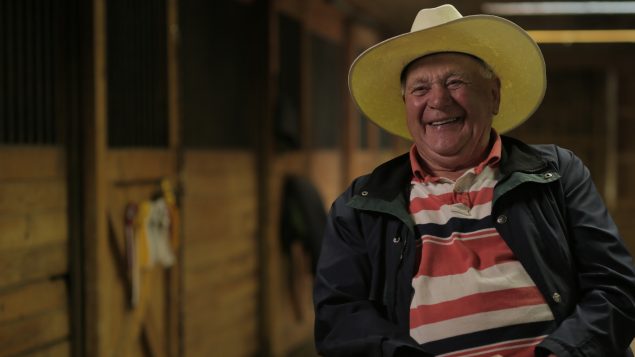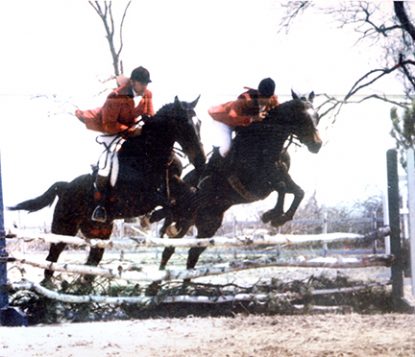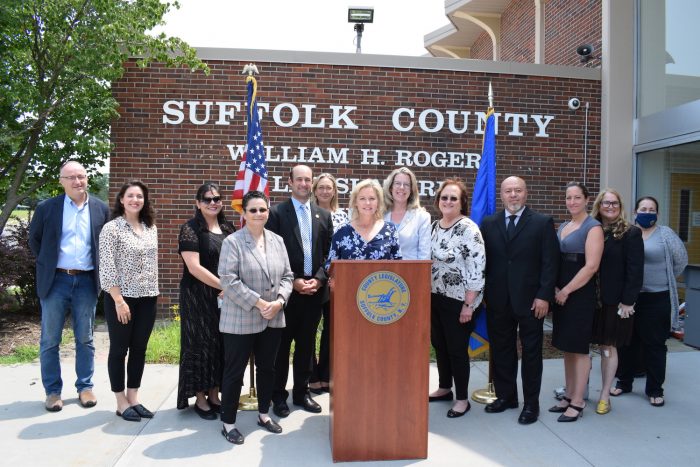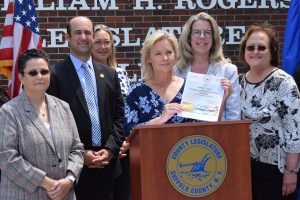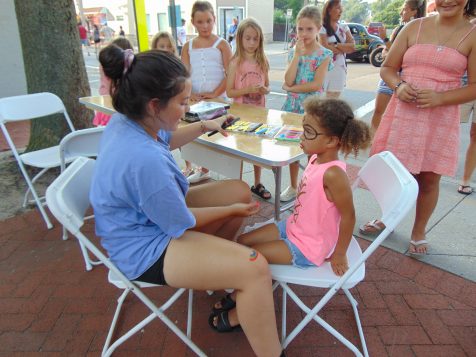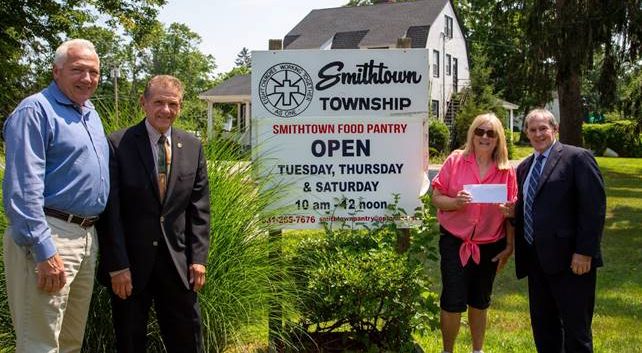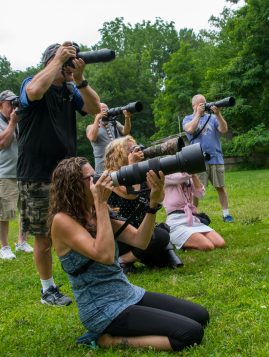A former St. James resident, who is remembered for saving an 8-year-old plow horse from a slaughterhouse and turning him into a champion, died June 25 in Stanardsville, Virginia, at the age of 93.
Harry de Leyer’s work and the bond with the horse named Snowman was documented in the 2011 book “The Eighty-Dollar Champion” by Elizabeth Letts and the 2016 film “Harry & Snowman” where the skill and heart of both were celebrated.
The well-known tale of him and Snowman, who was also known as “The Cinderella Horse,” began in 1956 when he saved the animal from a slaughterhouse in Pennsylvania for $80. De Leyer was late for a horse auction, but when he saw one of the last horses he knew the animal had potential to train young riders at The Knox School in Nissequogue where he worked.
“I came to this country with nothing in my pocket. Then I met Snowman and he made my name in this country.”
— Harry de Leyer
The equestrian and horse trainer would go on to turn the worn-out workhorse into the winner of the United States Equestrian Federation Horse of the Year in 1958 and land the “triple crown” of show jumping in the same year. Snowman also made history in 1959 as the first horse to win the Open Jumper Championship two years in a row. In 1983, de Leyer went on to represent the United States at the World Championships.
“I came to this country with nothing in my pocket,” de Leyer said in the 2016 documentary film. “Then I met Snowman and he made my name in this country.”
In the documentary, de Leyer talks about the time he attempted to sell Snowman to a doctor who lived a few miles away. A couple of days later, Snowman showed up at de Leyer’s property. The horse trainer thought the doctor may have left a gate open, but the new owner said that Snowman had jumped the gate. A few days later, after the doctor heightened the gate, Snowman once again came back to de Leyer. It was then the trainer realized the horse’s jumping potential and bought him back.
De Leyer was born in 1927 in Sint-Oedenrode, Netherlands, according to his obituary from Moloney Funeral Home. He was the oldest of 13 children, and his family was part of the underground during World War II and helped many Jews escape the Nazis through the Netherlands. De Leyer and his first wife, Johanna, came to America after de Leyer’s family sent the dog tags of a deceased soldier that they never met home to his parents.
He and Johanna were sponsored by the soldier’s family when they arrived the United States. His first job in the country was working on his sponsor’s farm in North Carolina where his talents for training and jumping horses were recognized.
Soon after they arrived in America, the couple headed for Long Island and raised eight children in St. James. In the 1970s de Leyer and Johanna divorced. Later in life, he had a farm in East Hampton and then moved to Virginia. He also married again to his second wife, Joan.
While living in St. James, in addition to being the riding instructor at The Knox School, he also gave lessons at his St. James home, Hollandia Farms.
After his passing, The Knox School posted on its Facebook page.
“Mr. de Leyer came to Knox in 1954 and was a beloved trainer and member of the school community,” the post read. “His legacy lives on in the hearts of those who remember how Mr. de Leyer saved Snowman from slaughter and turned a gentle giant of a plow horse into a champion jumper.”
The post announced that a stall in the school’s historic equestrian center will be dedicated to the memory of Harry and Snowman in the future.
Jackie Bittner, owner of Hidden Lake Farm Riding School in Southold, attended The Knox School for four years and took riding lessons from de Leyer. She said she was fortunate to keep in touch with him through the years and considered him a best friend. As a trainer, Bittner said, de Leyer was strict.
“Rightfully so,” she said. “He really wanted you to do the right thing and to be a good rider. He tried to make everyone a good rider.”
She said sometimes she would doubt if she was able to do a trick on a horse.
“He asked you to do all kinds of things, and I say, ‘Oh, I don’t know,’ but you would do whatever he asked with the horse, because he was just the type of person that you wanted to please.”
Janis Lando remembers taking lessons from him at Hollandia Farm when she lived in Smithtown.
“I rode as an early teen and remembered flying over fences without hands on the reins,” she said. “He believed in the soft-mouth approach and more control with one’s legs. I also recall him slipping a quarter under the knee, and he expected you to hold it there as you rode.”
When Laurette Berry was 13 years old and her family first moved from Manhattan to Stony Brook, she said her father signed up her and her siblings for lessons with de Leyer after a neighbor recommended him.
“The very first lesson we were jumping,” she said. “We had never been on a horse before in our lives. With Harry, you either were a daredevil or he wasn’t interested.”
“You were sitting on the horse’s back, but he was in full control of them. He was such a good trainer, and the horses just did whatever he wanted them to do.”
— Laurette Berry
After a few lessons, their father decided to go to another trainer as he was afraid his children would get hurt, but Berry remembers how in control de Leyer was of his horses during the short time she trained with him.
“He was like the ringleader in a circus where the animals just went,” she said. “You were sitting on the horse’s back, but he was in full control of them. He was such a good trainer, and the horses just did whatever he wanted them to do.”
A few years later, Berry became involved in the Smithtown Hunt Club where she encountered de Leyer once again. The club would conduct hunts all over Suffolk County from St. James, Old Field and even in the Hamptons. She remembered one time during a hunt being in the water in Head of the Harbor and seeing pieces of ice. She said de Leyer forged ahead as he did in other hunts as he wasn’t afraid of anything.
Barbara Clarke, of Bridgehampton, also was involved in the foxhunts with de Leyer in the ’70s.
“He was always enthusiastic and brought a lot of riders with him,” she said. “He loved it. He loved nothing better than following a pack of hounds through the woods.”
Clarke remembered de Leyer from when her sister-in-law Janice attended The Knox School, and Clarke would go to some of the horse shows to see the students compete, including at Madison Square Garden. She said he always made sure the girls were safe on the horses and described him as the “Pied Piper.”
De Leyer is predeceased by Johanna and Joan and his sons Joseph, Harry Jr. and William de Leyer. He is survived by his children Harriet de Leyer, Martin and Debbie de Leyer, Andre and Christine de Leyer, John and Maria de Leyer and AnnMarie de Leyer as well as his grandchildren Charissa, Cassandra, Johnathon, Kyle, Jason, Travis, Dylan, Michaela, Andre, Johanna, Emma, Philip, Heather, Jeffery and Shane; great-grandchildren Brayden and Addison and great-great-grandchild William Harry.

